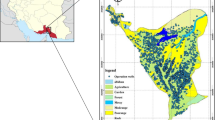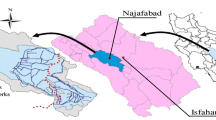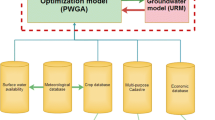Abstract
The need for irrigation water in arid and semi-arid regions is mostly supplied by groundwater. Furthermore, the agricultural development in these areas is not generally based on a comprehensive plan, which can cause aquifers depletion. On the other hand, to properly manage an aquifer and to have an optimal crop plan, the stochastic nature of the different parameters of a groundwater system such as groundwater recharge and water demands should be taken into consideration. In this paper, we develop an explicit stochastic optimization model for Firouzabad aquifer in Iran. This formulation is based on the first and second moment analysis for groundwater head which has been initially proposed for surface water resources management by Fletcher and Ponnambalam. We extend the model to create a new random withdrawal policy for conjunctive use setting in which the randomness in available precipitation is taken into account. The interesting point is that the model provides the respective probabilities of shortage and surplus without imposing the extra decision variables into the optimization model. A genetic-based algorithm is used to solve the stochastic nonlinear and non-convex formulation. The outcome results indicate that the current crop pattern should be changed, that is, the allocated areas of some crops have to be meaningfully reduced. Finally, to validate our model efficiency, we demonstrate that how much close the statistical characteristics obtained from the optimization model are to those estimated from the Monte Carlo simulation. Furthermore, the optimal benefits obtained using the proposed optimization model are as suitable as the benefits achieved using the corresponding Monte Carlo-based optimization model.


Similar content being viewed by others
References
Allen GA, Pereira LS, Raes D, Smith M (1998) Crop evapotranspiration—guidelines for computing crop water requirements. FAO Irrigation and Drainage Paper 56. FAO, Rome, Italy
Benli B, Kodal S (2003) A non-linear model for farm optimization with adequate and limited water supplies: application to the South-east Anatolian Project (GAP) Region. Agric Water Manag 62:187–203
Dariane A, Momtahen S (2009) Optimization of multireservoir systems operation using modified direct search genetic algorithm. J Water Resour Plan Manag 135:141–148
Das A, Datta B (2001) Application of optimization techniques in groundwater quantity and quality management. Sadhana 26:293–316
Das Gupta A, Onta PR (1997) Sustainable groundwater resources development. Hydrol Sci J 42(4):565–582
Fars Regional Water Authority (2010) Groundwater resources assessment in the Firouzabad Plain. Office of the Basic Researches on Water Resources Report, Shiraz, Iran [In Persian]
Feyen L, Gorelick SM (2004) Reliable groundwater management in hydroecologically sensitive areas. Water Resour Res 40:W07408
Fletcher SG, Ponnambalam K (1996a) Estimation of reservoir yield and storage distribution using moments analysis. J Hydrol 182:259–275
Fletcher SG, Ponnambalam K (1996b) A new formulation for the stochastic control of systems with bounded state variables: an application to reservoir systems. Stoch Hydrol Hydraul 10:167–186
Fletcher SG, Ponnambalam K (1998) A constrained state formulation for the stochastic control of multi-reservoir systems. Water Resour Res 34:257–270
Fletcher SG, Ponnambalam K (2008) Stochastic control of reservoir systems using indicator functions: new enhancements. Water Resour Res 44:1–10
Flores EZ, Gutjahr AL, Gelhar LW (1978) A stochastic model of the operation of a stream-aquifer system. Water Resour Res 14:30–38
Freeze RA, Gorelick SM (1999) Convergence of stochastic optimization and decision analysis in the engineering design of aquifer remediation. Gr Water 37:934–954
Ganji A, Jowkarshorijeh L (2012) Advance first order second moment (AFOSM) method for single reservoir operation reliability analysis: a case study. Stoch Environ Res Risk Assess 26:33–42
Ganji A, Ponnambalam K, Khalili D, Karamouz M (2006a) A new stochastic optimization model for deficit irrigation. Irrig Sci J 25:63–73
Ganji A, Ponnambalam K, Khalili D, Karamouz M (2006b) Grain yield reliability analysis with crop water demand uncertainty. Stoch Environ Res Risk Assess 20:259–277
Gen M, Cheng R (2000) Genetic algorithm and engineering optimization. Wiley-Interscience publication, New York
Goldberg D (1989) Genetic algorithms in search optimization and machine learning. Addison-Wesley, Reading
Guan J, Kentel E, Aral M (2008) Genetic algorithm for constrained optimization models and its application in groundwater resources management. J Water Resour Plan Manag 134:64–72
Iran Ministry of Jihad-e-Agriculture (2010) Annual agricultural statistics. Available in http://www.maj.ir [In Persian]. Accessed 10 Sep 2012
Karamouz M, Zahraie B, Kerachian R, Eslami A (2008) Crop pattern and conjunctive use management: a case study. Irrig Drain 59:161–173
Karimi H (1998) Hydrogeological and hydrochemical evaluation of springs and piezometers of Podenow anticline, Firozabad. Dissertation, Shiraz University [In Persian]
Karimi H, Raeisi E, Zare M (2005) Physicochemical time series of karst springs as a tool to differentiate the source of spring water. Carbonate Evaporite 20:138–147
Knapp KC, Olson LJ (1995) The economics of conjunctive groundwater management with stochastic surface supplies. J Environ Econ Manag 28:340–356
Ko NY, Lee KK (2008) Reliability and remediation cost of optimal remediation design considering uncertainty in aquifer parameters. J Water Resour Plan Manag 134:413–421
Madani K (2014) Water management in Iran: what is causing the looming crisis? J Environ Stud Sci. doi:10.1007/s13412-014-0182-z
Mahab Ghodss Consulting Engineering Company (1985) Hydrogeology of the Firouzabad Plain. Mahab Ghodss Consulting Engineering Company Report. Fars Regional Water Authority, Shiraz, Iran [In Persian]
Mahootchi M, Ponnambalam K (2013) Parambikulam-aliyar project operations optimization with reliability constraints. J Water Resour Plan Manag 139:364–375
Mahootchi M, Ponnambalam K, Tizhoosh HR (2010) Operations optimization of multireservoir systems using storage moments equations. Adv Water Resour 33:1150–1163
Michalewicz Z (1994) Genetic algorithms + data structures = evolution programs, 2nd edn. Springer, New York
Ndambuki JM, Otieno FAO, Stroet CBM, Veling EJM (2000) Groundwater management under uncertainty: a multi-objective approach. Water SA 26(1):35–41
Nicklow J, Reed P, Savic D, Dessalegne T et al (2010) State of the art for genetic algorithms and beyond in water resources planning and management. J Water Resour Plan Manag 136:412–432
Onta PR, Gupta AD, Harboe R (1991) Multistep planning model for conjunctive use of surface and groundwater resources. J Water Resour Plan Manag 117:662–678
Parab Fars Consulting Engineering Company (2010) Water balance studies in Mond River Basin. Parab Fars Consulting Engineering Company Report. Fars Regional Water Authority, Shiraz, Iran [In Persian]
Scozzafava M, Tallini M (2001) Net infiltration in the Gran Sasso Massif of central Italy using the Thornthwaite water balance and curve-number method. Hydrogeol J 9:461–475
Sethi LN, Panda SN, Nayak MK (2006) Optimal crop planning and water resources allocation in a coastal groundwater basin, Orissa, India. Agric Water Manag 83:209–220
Simonovic SP, Srinivasan R (1993) Explicit stochastic approach for planning the operations of reservoirs for hydropower production. Extreme hydrological events: precipitation, floods and droughts, Proceedings of the Yokohama Symposium. IAHS Publ 213:349–349
Singh A, Panda SN (2012) Development and application of an optimization model for the maximization of net agricultural return. Agric Water Manag 115:267–275
Srikanthan R, McMahon TA, Sharma A (2002) Stochastic generation of monthly rainfall data. Cooperative Research Centre for Catchment Hydrology, Technical Report 02/8
Thorsen M, Refsgaard JC, Hansen S, Pebesma E, Jensen JB, Kleeschulte S (2001) Assessment of uncertainty in simulation of nitrate leaching to aquifers at catchment scale. J Hydrol 242:210–227
Tung YK (1986) Groundwater management by chance-constrained model. J Water Resour Plan Manag 112:1–19
Van den Brink C, Zaadnoordijk WJ, Burgers S, Griffioen J (2008) Stochastic uncertainties and sensitivities of a regional scale transport model of nitrate in groundwater. J Hydrol 361:309–318
Wagner BJ, Gorelick SM (1987) Optimal groundwater quality management under parameter uncertainty. Water Resour Res 23:1162–1174
Wardlaw R, Sharif M (1999) Evaluation of genetic algorithms for optimal reservoir system operation. J Water Resour Plan Manag 125:25–33
Wu J, Zheng L, Liu D (2007) Optimizing groundwater development strategies by genetic algorithm: a case study for balancing the needs for agricultural irrigation and environmental protection in northern China. Hydrogeol J 15:1265–1278
Yang XS (2010) Engineering optimization: An introduction with metaheuristic applications. Wiley, Hoboken
Zeitouni N (2004) Optimal extraction from a renewable groundwater aquifer with stochastic recharge. Water Resour Res 40:W06517
Zhang JL, Ponnambalam K (2005) Stochastic control for risk under deregulated electricity market-a case study using a new formulation. Can J Civ Eng 32:719–725
Acknowledgments
The authors would like to acknowledge Dr. Mohammad Bagher Ahmadi, from Department of Mathematics, Shiraz University (Iran) for his generous help. We also thank the editors and anonymous reviewers of the journal for their valuable comments, suggestions and positive feedback.
Author information
Authors and Affiliations
Corresponding author
Rights and permissions
About this article
Cite this article
Joodavi, A., Zare, M. & Mahootchi, M. Development and application of a stochastic optimization model for groundwater management: crop pattern and conjunctive use consideration. Stoch Environ Res Risk Assess 29, 1637–1648 (2015). https://doi.org/10.1007/s00477-015-1049-x
Published:
Issue Date:
DOI: https://doi.org/10.1007/s00477-015-1049-x




